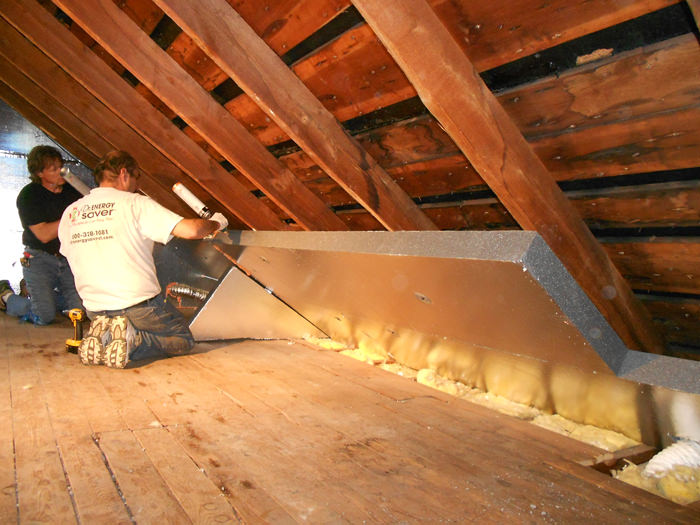

A radiant barrier that is non-perforated will not allow water vapor to pass through. Third, you should know the difference between perforated and non-perforated radiant barriers. Accumulation of dust on the foil surface will lower reflectiveness, and this is one reason that the installation of a radiant barrier on the attic floor, rather than the ceiling, could be problematic. Second, a radiant barrier is only effective if it is reflective. If they’re sandwiched between two pieces of insulation or siding, they become conductors and will actively be working against your insulation. First, radiant barriers need an air space in front of them. There are a few things to keep in mind if you want to preserve the effectiveness of a radiant barrier. Again, in this case, installing a radiant barrier is usually a simpler and less expensive project than installing insulation in your attic. Unfortunately, a lot of older homes have ductwork in unconditioned attics. Keeping your attic cool is extra important if you have air-conditioning ducts running through it. Buildings with metal roofs could benefit greatly from radiant barriers, since metal can get very hot under the sun. You may also want to consider installing a radiant barrier in barns or outbuildings that are poorly or not at all insulated. If you live in the northern hemisphere and your roof is south-facing, a radiant barrier will be more effective on that side. The primary job of a radiant barrier is to reduce heat gain from a hot roof, and a roof that gets more sun exposure will get hotter. If you have an older home with poorer insulation, a radiant barrier may be a cheaper option than replacing insulation. Insulation prevents conductive heat from entering your home by absorbing it, and that means there will be less heat for the radiant barrier to mitigate. The more insulated your attic, the less difference a radiant barrier will make. Here are some situations where a radiant barrier might benefit you most: Your attic is poorly insulated. The value of a radiant barrier in your home depends on your climate, sun exposure, and current insulation. Older homes can be retrofitted for extra energy savings by attaching radiant barrier material to the attic ceiling or floor. Radiant barrier sheathing, which is plywood or OSB board with foil adhered to one side, is often used in new homes, with the foil facing into the attic space. Department of Energy says that radiant barriers can reduce cooling costs by 5-10 percent in a warm, sunny climate. Radiant barriers have the most impact in reducing radiant heat gain during the summer. A radiant barrier will reflect this heat back toward the roof, keeping your house cooler in the summer. When infrared radiation from the sun hits a home’s roof, it heats up the roofing material, which then radiates that heat back out in all directions. 500 SQUARE FEET ROLL - 4 feet x 125 feet BREATHABLE, PERFORATED, DOUBLE-SIDED, REINFORCED Engineered Foil radiant barrier.A radiant barrier is a reflective surface that prevents radiant heat from entering a home’s heat envelope.Also used in barns, metal buildings, and poultry houses. Frequently used as House Wrap for additional insulation.
#ATTIC RADIANT BARRIER INSULATION INSTALL#
EASY TO INSTALL - in existing homes or new constructions, by stapling to the bottom of rafters and over attic floor.Blocks 95% heat radiating from the underside of a hot roof. PAYS FOR ITSELF - by reducing heating cost in winter and cooling cost in summer.Both sides reflects 95% of the radiant heat. INDUSTRIAL / COMMERCIAL GRADE - SmartFOIL Radiant Barrier is TEAR & PUNCTURE PROOF, but you can easily cut it with utility scissors.Corrosion resistance according to D3310 is achieved by a proprietary clear coating applied to the Engineered Foil surface. MEETS OR EXCEEDS ALL ASTM C1313 STANDARDS - Class A Fire Rating (E84 with E2599 mounting).FIRE RATING: Class A / Class 1 (ASTM E-84) - Meets fire and smoke requirements for most local, state and federal building codes.
#ATTIC RADIANT BARRIER INSULATION FREE#
Product works equally well in both hot and cold environment!!! Non-toxic non-carcinogenic fiber free easy to install not affected by humidity maintenance free does not promote the growth of fungi or bacteria does not support nesting by rodents or insects. Combined with existing mass insulation, you can significantly improve the comfort of your home and SAVE BIG on YOUR ELECTRIC BILLS. Unlike traditional mass insulations like blown-in and batt cellulose/fiberglass, SmartFOIL radiant barrier blocks 95% of the radiant heat, thereby greatly reducing the amount of heat that enters a home when installed in the attic space or as a house wrap.


 0 kommentar(er)
0 kommentar(er)
